SHR039-6 Project Plan: Samsung Smartphone Development Project
VerifiedAdded on 2023/06/12
|28
|3251
|254
Project
AI Summary
This document outlines a project plan for Samsung's development of a new smartphone, aiming to leverage innovation for cost leadership. The plan details project objectives, scope, constraints, assumptions, deliverables, milestones, and a comprehensive schedule spanning nearly two years (May 2018 to September 2020). It includes a Gantt chart, network diagram, work breakdown structure, and a detailed project budget. The plan also addresses quality control and risk management. While the primary approach is a structured project management framework, the document acknowledges the potential need for agile methodologies as a contingency. The project encompasses product planning, requirement analysis, production development, testing, product launch, and ongoing monitoring.
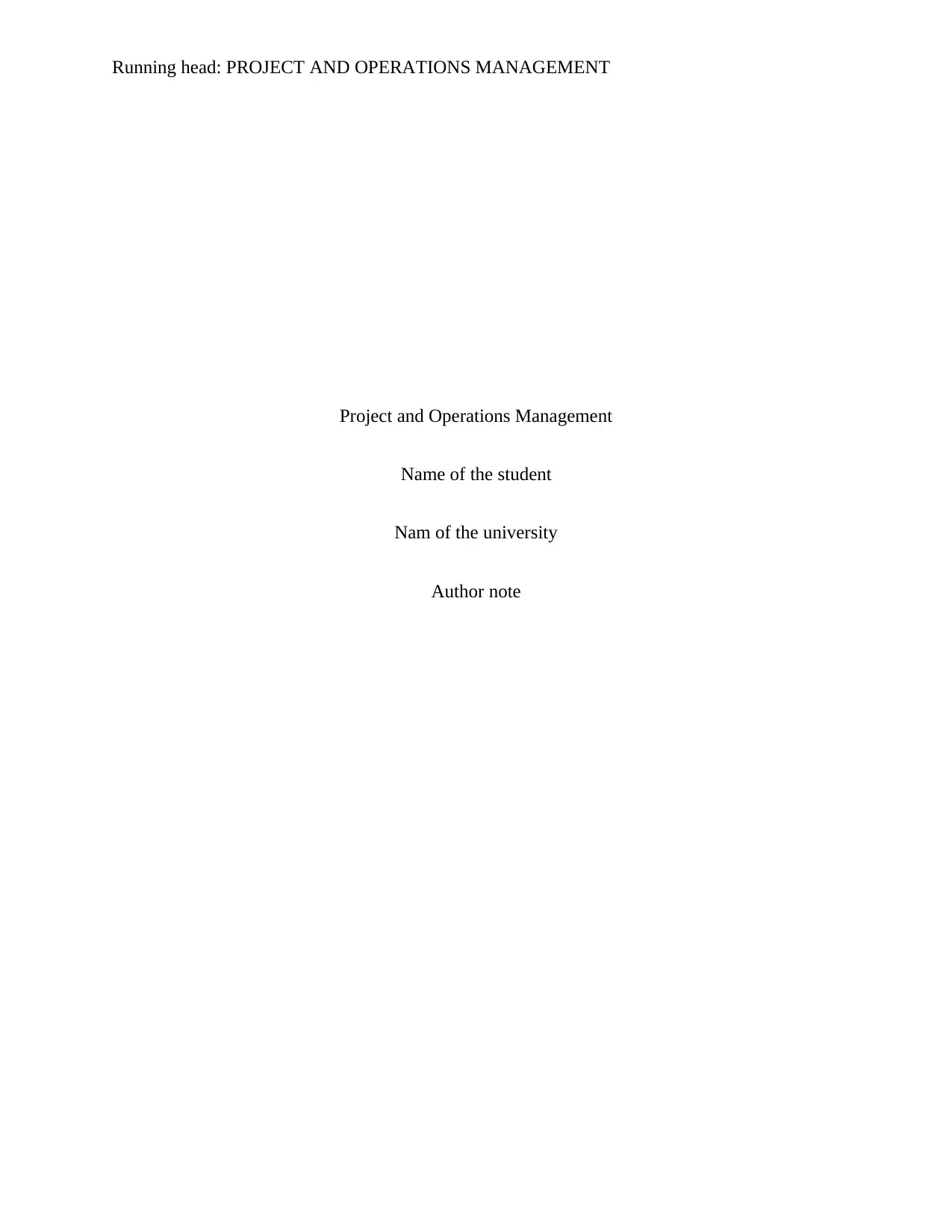
Running head: PROJECT AND OPERATIONS MANAGEMENT
Project and Operations Management
Name of the student
Nam of the university
Author note
Project and Operations Management
Name of the student
Nam of the university
Author note
Paraphrase This Document
Need a fresh take? Get an instant paraphrase of this document with our AI Paraphraser
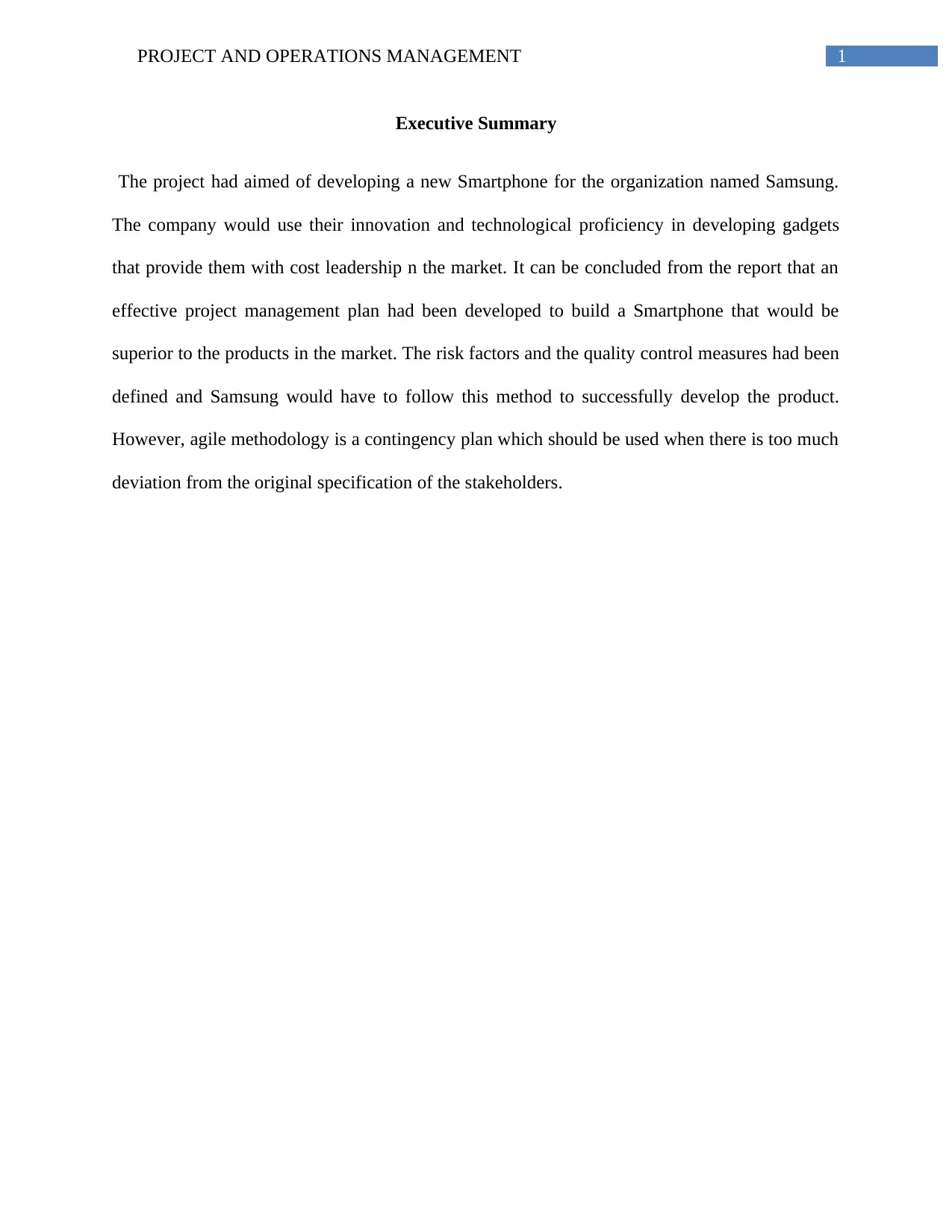
1PROJECT AND OPERATIONS MANAGEMENT
Executive Summary
The project had aimed of developing a new Smartphone for the organization named Samsung.
The company would use their innovation and technological proficiency in developing gadgets
that provide them with cost leadership n the market. It can be concluded from the report that an
effective project management plan had been developed to build a Smartphone that would be
superior to the products in the market. The risk factors and the quality control measures had been
defined and Samsung would have to follow this method to successfully develop the product.
However, agile methodology is a contingency plan which should be used when there is too much
deviation from the original specification of the stakeholders.
Executive Summary
The project had aimed of developing a new Smartphone for the organization named Samsung.
The company would use their innovation and technological proficiency in developing gadgets
that provide them with cost leadership n the market. It can be concluded from the report that an
effective project management plan had been developed to build a Smartphone that would be
superior to the products in the market. The risk factors and the quality control measures had been
defined and Samsung would have to follow this method to successfully develop the product.
However, agile methodology is a contingency plan which should be used when there is too much
deviation from the original specification of the stakeholders.
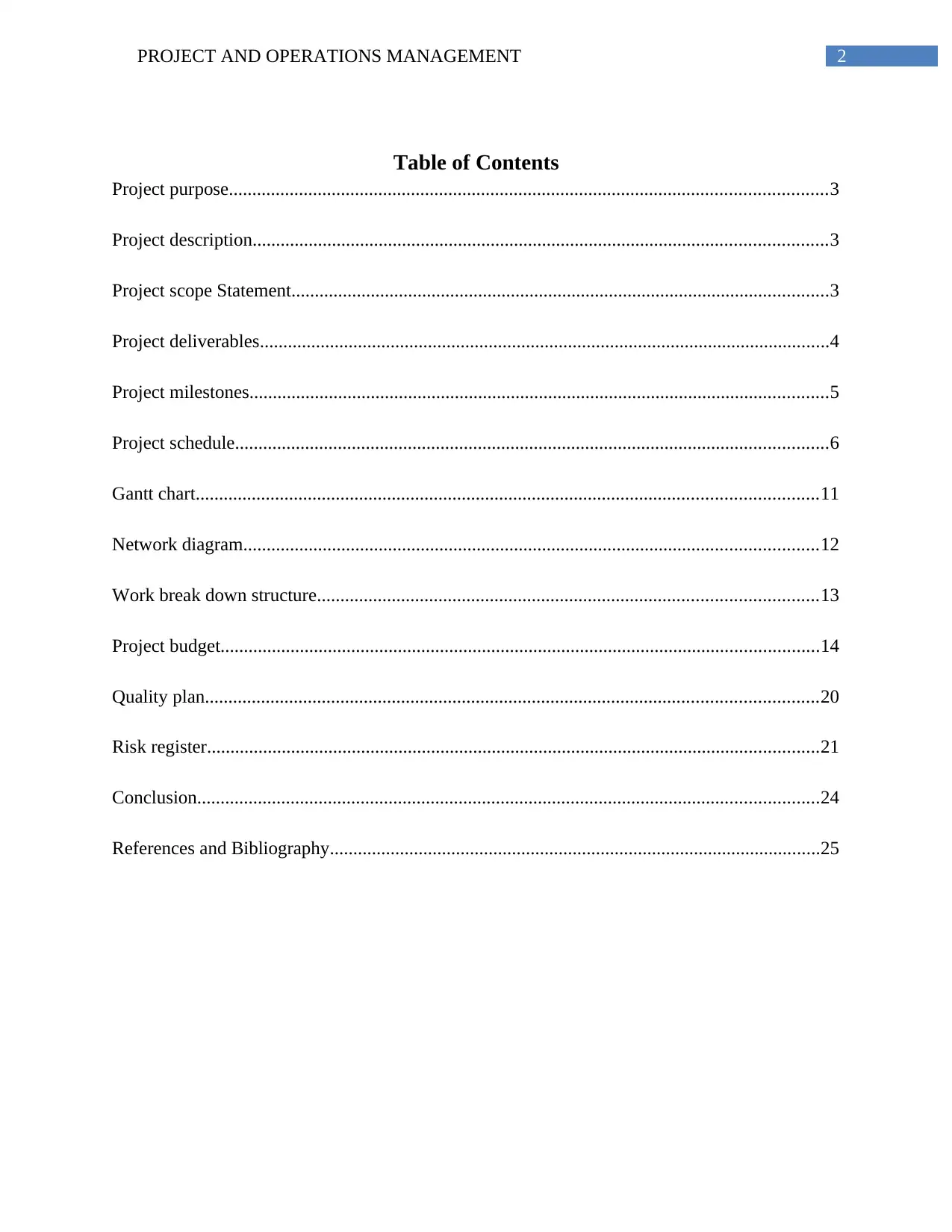
2PROJECT AND OPERATIONS MANAGEMENT
Table of Contents
Project purpose................................................................................................................................3
Project description...........................................................................................................................3
Project scope Statement...................................................................................................................3
Project deliverables..........................................................................................................................4
Project milestones............................................................................................................................5
Project schedule...............................................................................................................................6
Gantt chart.....................................................................................................................................11
Network diagram...........................................................................................................................12
Work break down structure...........................................................................................................13
Project budget................................................................................................................................14
Quality plan...................................................................................................................................20
Risk register...................................................................................................................................21
Conclusion.....................................................................................................................................24
References and Bibliography.........................................................................................................25
Table of Contents
Project purpose................................................................................................................................3
Project description...........................................................................................................................3
Project scope Statement...................................................................................................................3
Project deliverables..........................................................................................................................4
Project milestones............................................................................................................................5
Project schedule...............................................................................................................................6
Gantt chart.....................................................................................................................................11
Network diagram...........................................................................................................................12
Work break down structure...........................................................................................................13
Project budget................................................................................................................................14
Quality plan...................................................................................................................................20
Risk register...................................................................................................................................21
Conclusion.....................................................................................................................................24
References and Bibliography.........................................................................................................25
⊘ This is a preview!⊘
Do you want full access?
Subscribe today to unlock all pages.

Trusted by 1+ million students worldwide
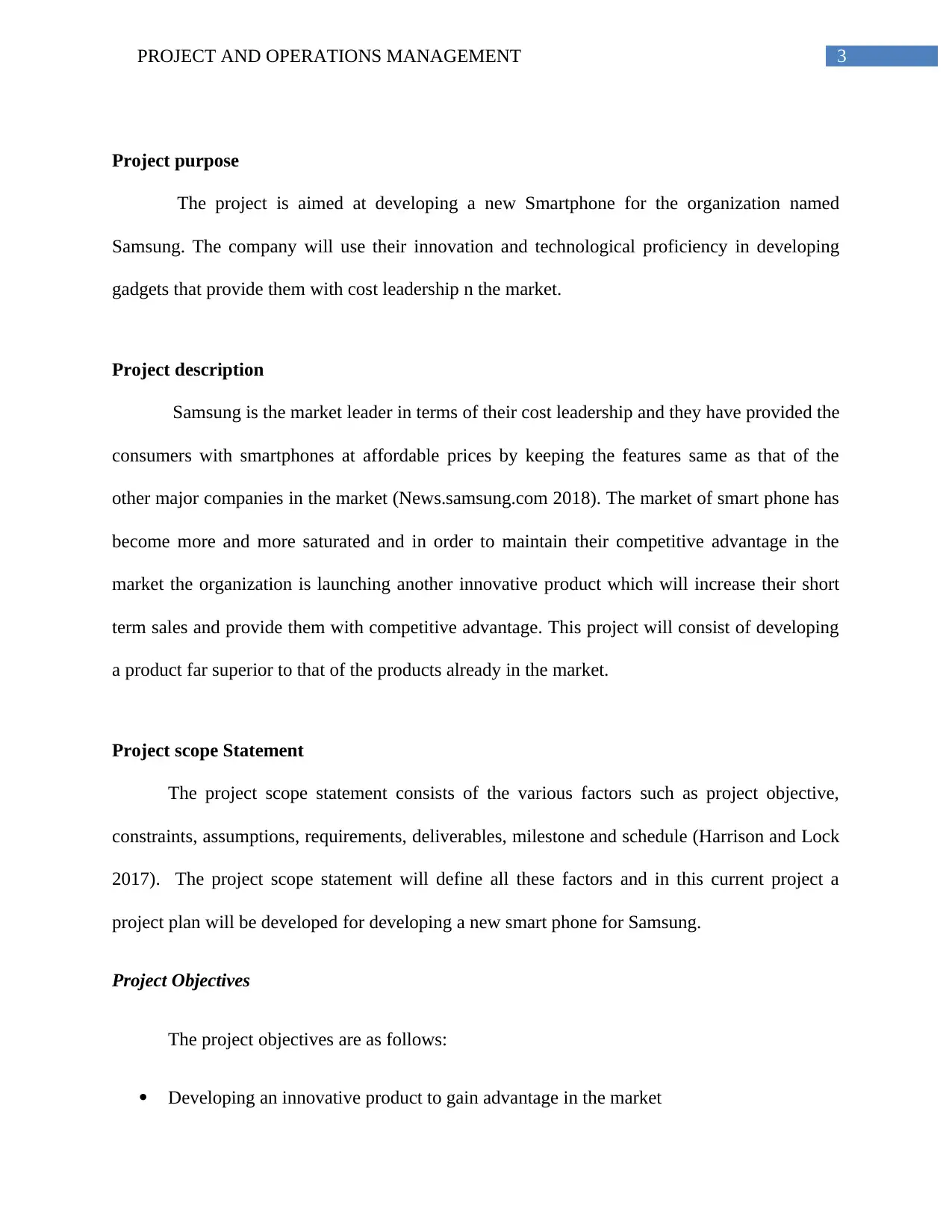
3PROJECT AND OPERATIONS MANAGEMENT
Project purpose
The project is aimed at developing a new Smartphone for the organization named
Samsung. The company will use their innovation and technological proficiency in developing
gadgets that provide them with cost leadership n the market.
Project description
Samsung is the market leader in terms of their cost leadership and they have provided the
consumers with smartphones at affordable prices by keeping the features same as that of the
other major companies in the market (News.samsung.com 2018). The market of smart phone has
become more and more saturated and in order to maintain their competitive advantage in the
market the organization is launching another innovative product which will increase their short
term sales and provide them with competitive advantage. This project will consist of developing
a product far superior to that of the products already in the market.
Project scope Statement
The project scope statement consists of the various factors such as project objective,
constraints, assumptions, requirements, deliverables, milestone and schedule (Harrison and Lock
2017). The project scope statement will define all these factors and in this current project a
project plan will be developed for developing a new smart phone for Samsung.
Project Objectives
The project objectives are as follows:
Developing an innovative product to gain advantage in the market
Project purpose
The project is aimed at developing a new Smartphone for the organization named
Samsung. The company will use their innovation and technological proficiency in developing
gadgets that provide them with cost leadership n the market.
Project description
Samsung is the market leader in terms of their cost leadership and they have provided the
consumers with smartphones at affordable prices by keeping the features same as that of the
other major companies in the market (News.samsung.com 2018). The market of smart phone has
become more and more saturated and in order to maintain their competitive advantage in the
market the organization is launching another innovative product which will increase their short
term sales and provide them with competitive advantage. This project will consist of developing
a product far superior to that of the products already in the market.
Project scope Statement
The project scope statement consists of the various factors such as project objective,
constraints, assumptions, requirements, deliverables, milestone and schedule (Harrison and Lock
2017). The project scope statement will define all these factors and in this current project a
project plan will be developed for developing a new smart phone for Samsung.
Project Objectives
The project objectives are as follows:
Developing an innovative product to gain advantage in the market
Paraphrase This Document
Need a fresh take? Get an instant paraphrase of this document with our AI Paraphraser

4PROJECT AND OPERATIONS MANAGEMENT
Market the product
Testing and launching of the product
Project Assumptions
The assumptions made in the project are as follows:
The CEO, board and the other stakeholder have approved the project
The different departments have been made aware of the project and its purpose
Project constraint
The time and budget of the project is a big constraint as Samsung uses cost leadership so
developing economies of scale is important in this project. Therefore, the project will have to
make sure that unnecessary over allocation of resources have to be avoided especially while
executing the non critical tasks in the study.
Project deliverables
The outputs of the different phases of the project are known as project deliverables and
defining project deliverables are essential to understand the variation in the results achieved in
each stage (Maylor, Turner and Murray-Webster 2015). The project deliverables in the current
project are listed below:
Task Name Duration Start Finish
Samsung Smartphone product
development
598 days Mon 5/21/18 Wed 9/2/20
Market the product
Testing and launching of the product
Project Assumptions
The assumptions made in the project are as follows:
The CEO, board and the other stakeholder have approved the project
The different departments have been made aware of the project and its purpose
Project constraint
The time and budget of the project is a big constraint as Samsung uses cost leadership so
developing economies of scale is important in this project. Therefore, the project will have to
make sure that unnecessary over allocation of resources have to be avoided especially while
executing the non critical tasks in the study.
Project deliverables
The outputs of the different phases of the project are known as project deliverables and
defining project deliverables are essential to understand the variation in the results achieved in
each stage (Maylor, Turner and Murray-Webster 2015). The project deliverables in the current
project are listed below:
Task Name Duration Start Finish
Samsung Smartphone product
development
598 days Mon 5/21/18 Wed 9/2/20
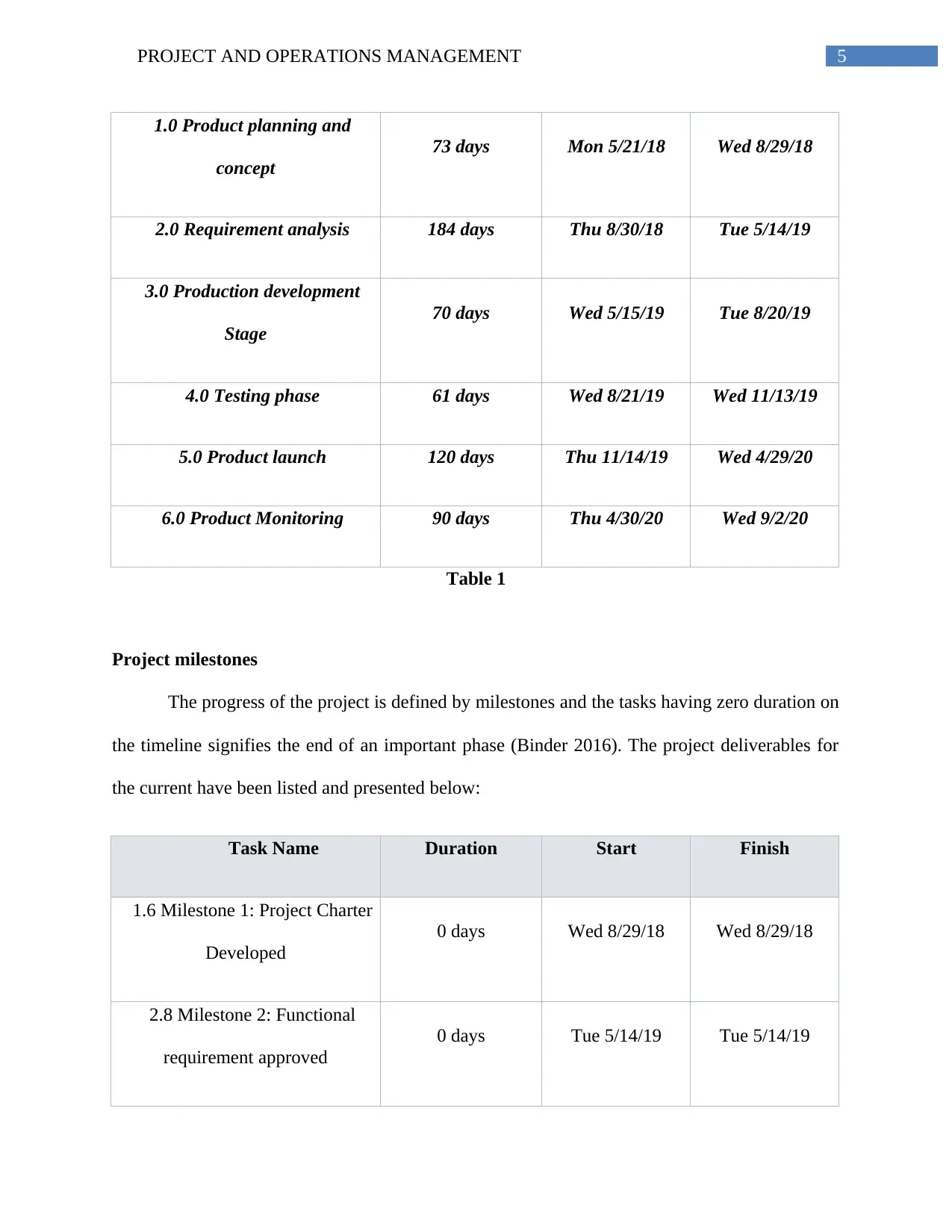
5PROJECT AND OPERATIONS MANAGEMENT
1.0 Product planning and
concept
73 days Mon 5/21/18 Wed 8/29/18
2.0 Requirement analysis 184 days Thu 8/30/18 Tue 5/14/19
3.0 Production development
Stage
70 days Wed 5/15/19 Tue 8/20/19
4.0 Testing phase 61 days Wed 8/21/19 Wed 11/13/19
5.0 Product launch 120 days Thu 11/14/19 Wed 4/29/20
6.0 Product Monitoring 90 days Thu 4/30/20 Wed 9/2/20
Table 1
Project milestones
The progress of the project is defined by milestones and the tasks having zero duration on
the timeline signifies the end of an important phase (Binder 2016). The project deliverables for
the current have been listed and presented below:
Task Name Duration Start Finish
1.6 Milestone 1: Project Charter
Developed
0 days Wed 8/29/18 Wed 8/29/18
2.8 Milestone 2: Functional
requirement approved
0 days Tue 5/14/19 Tue 5/14/19
1.0 Product planning and
concept
73 days Mon 5/21/18 Wed 8/29/18
2.0 Requirement analysis 184 days Thu 8/30/18 Tue 5/14/19
3.0 Production development
Stage
70 days Wed 5/15/19 Tue 8/20/19
4.0 Testing phase 61 days Wed 8/21/19 Wed 11/13/19
5.0 Product launch 120 days Thu 11/14/19 Wed 4/29/20
6.0 Product Monitoring 90 days Thu 4/30/20 Wed 9/2/20
Table 1
Project milestones
The progress of the project is defined by milestones and the tasks having zero duration on
the timeline signifies the end of an important phase (Binder 2016). The project deliverables for
the current have been listed and presented below:
Task Name Duration Start Finish
1.6 Milestone 1: Project Charter
Developed
0 days Wed 8/29/18 Wed 8/29/18
2.8 Milestone 2: Functional
requirement approved
0 days Tue 5/14/19 Tue 5/14/19
⊘ This is a preview!⊘
Do you want full access?
Subscribe today to unlock all pages.

Trusted by 1+ million students worldwide
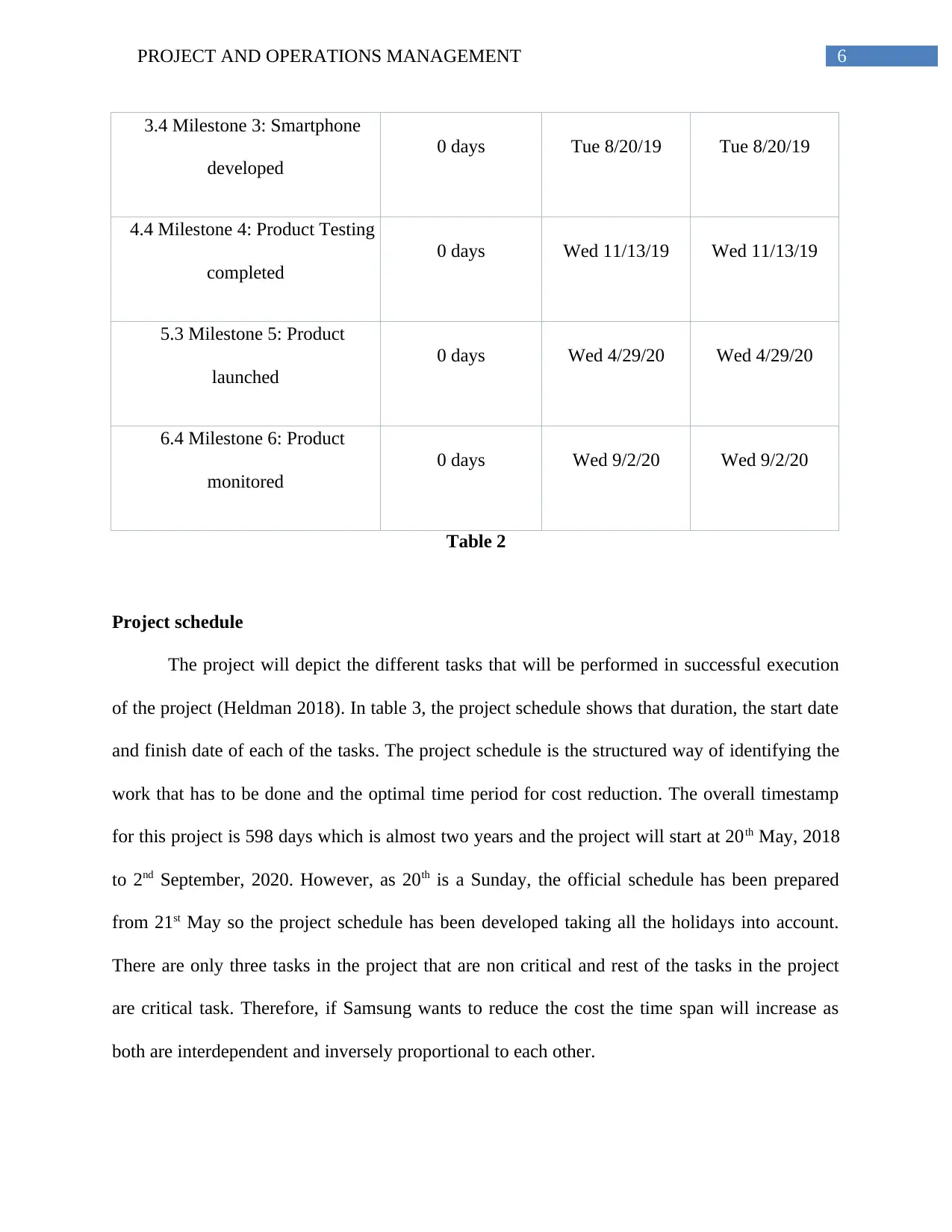
6PROJECT AND OPERATIONS MANAGEMENT
3.4 Milestone 3: Smartphone
developed
0 days Tue 8/20/19 Tue 8/20/19
4.4 Milestone 4: Product Testing
completed
0 days Wed 11/13/19 Wed 11/13/19
5.3 Milestone 5: Product
launched
0 days Wed 4/29/20 Wed 4/29/20
6.4 Milestone 6: Product
monitored
0 days Wed 9/2/20 Wed 9/2/20
Table 2
Project schedule
The project will depict the different tasks that will be performed in successful execution
of the project (Heldman 2018). In table 3, the project schedule shows that duration, the start date
and finish date of each of the tasks. The project schedule is the structured way of identifying the
work that has to be done and the optimal time period for cost reduction. The overall timestamp
for this project is 598 days which is almost two years and the project will start at 20th May, 2018
to 2nd September, 2020. However, as 20th is a Sunday, the official schedule has been prepared
from 21st May so the project schedule has been developed taking all the holidays into account.
There are only three tasks in the project that are non critical and rest of the tasks in the project
are critical task. Therefore, if Samsung wants to reduce the cost the time span will increase as
both are interdependent and inversely proportional to each other.
3.4 Milestone 3: Smartphone
developed
0 days Tue 8/20/19 Tue 8/20/19
4.4 Milestone 4: Product Testing
completed
0 days Wed 11/13/19 Wed 11/13/19
5.3 Milestone 5: Product
launched
0 days Wed 4/29/20 Wed 4/29/20
6.4 Milestone 6: Product
monitored
0 days Wed 9/2/20 Wed 9/2/20
Table 2
Project schedule
The project will depict the different tasks that will be performed in successful execution
of the project (Heldman 2018). In table 3, the project schedule shows that duration, the start date
and finish date of each of the tasks. The project schedule is the structured way of identifying the
work that has to be done and the optimal time period for cost reduction. The overall timestamp
for this project is 598 days which is almost two years and the project will start at 20th May, 2018
to 2nd September, 2020. However, as 20th is a Sunday, the official schedule has been prepared
from 21st May so the project schedule has been developed taking all the holidays into account.
There are only three tasks in the project that are non critical and rest of the tasks in the project
are critical task. Therefore, if Samsung wants to reduce the cost the time span will increase as
both are interdependent and inversely proportional to each other.
Paraphrase This Document
Need a fresh take? Get an instant paraphrase of this document with our AI Paraphraser
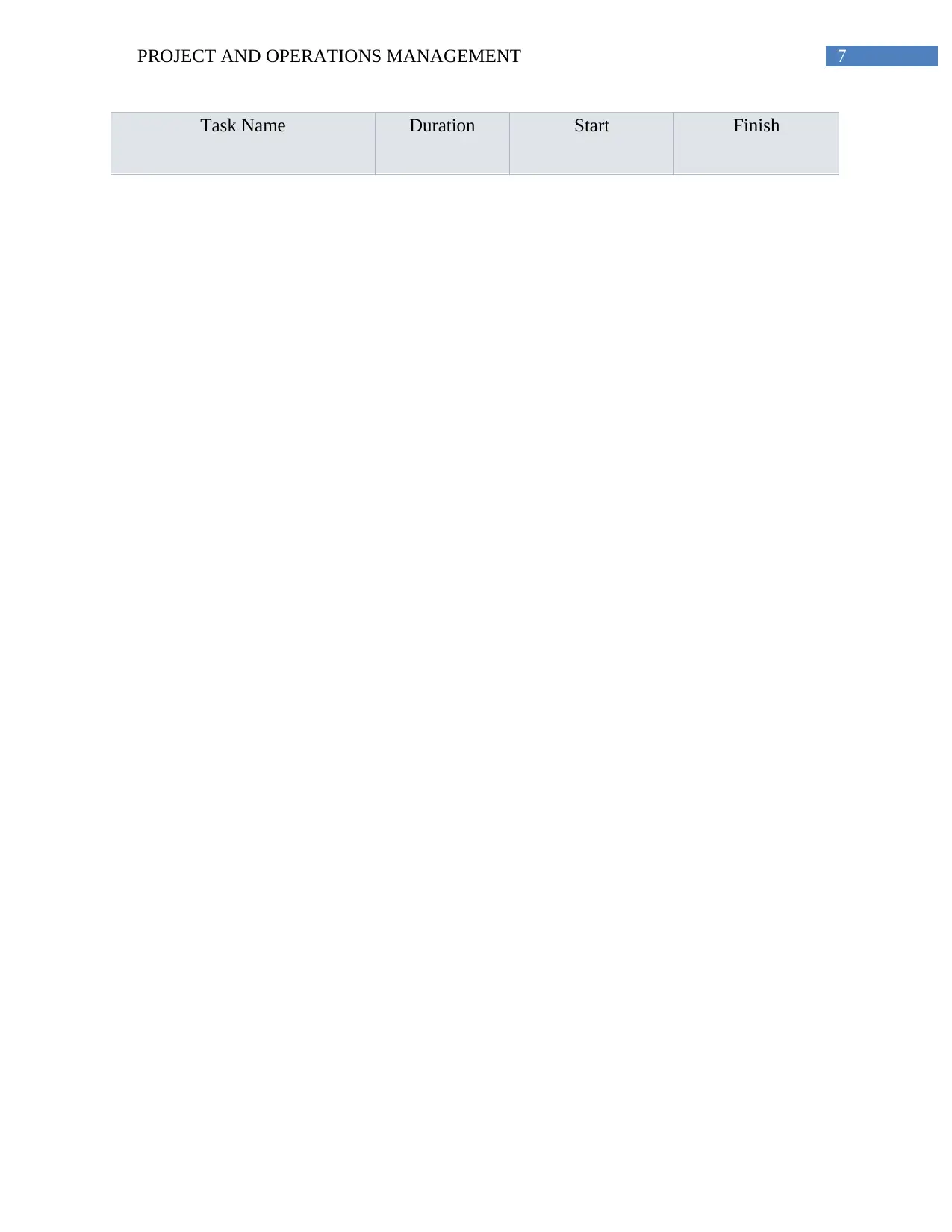
7PROJECT AND OPERATIONS MANAGEMENT
Task Name Duration Start Finish
Task Name Duration Start Finish
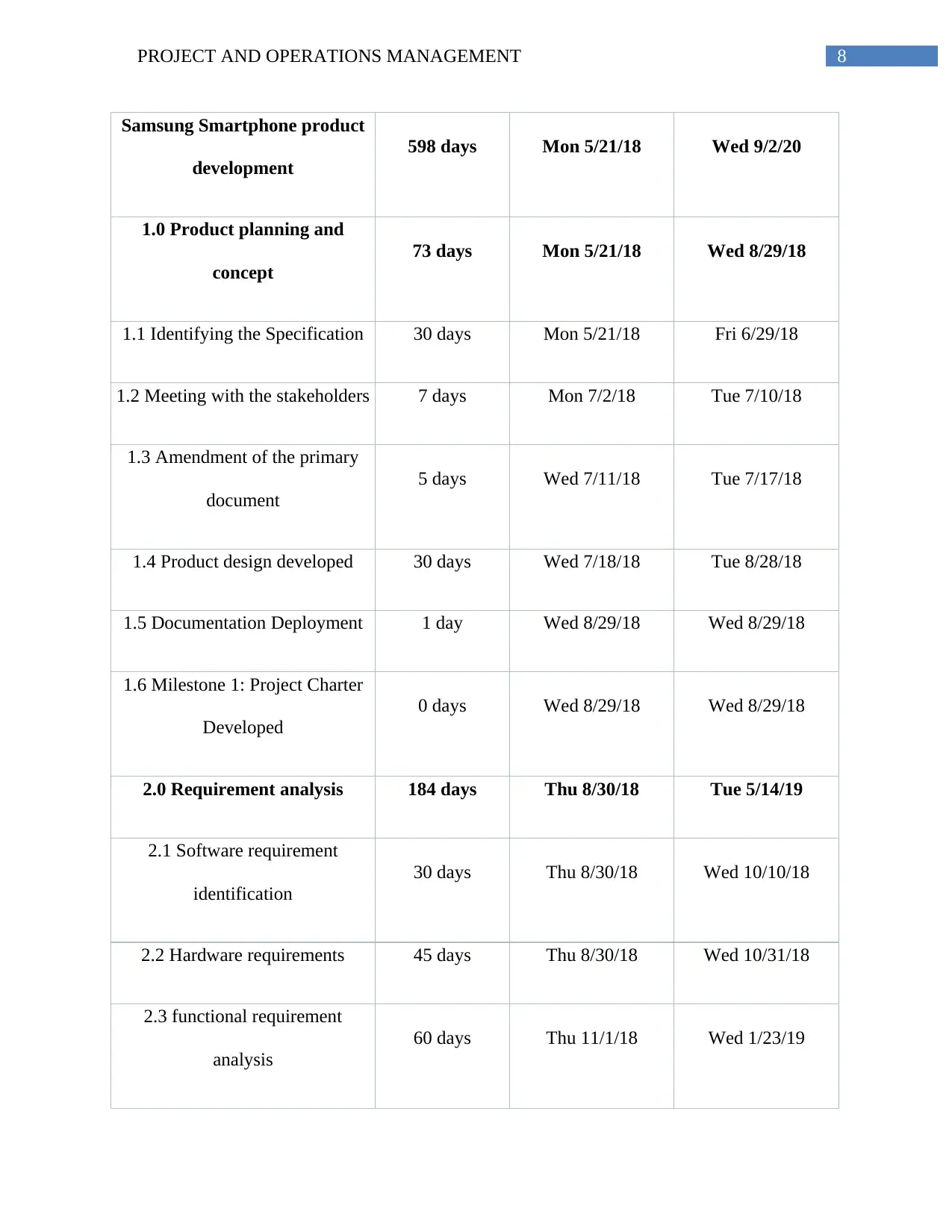
8PROJECT AND OPERATIONS MANAGEMENT
Samsung Smartphone product
development
598 days Mon 5/21/18 Wed 9/2/20
1.0 Product planning and
concept
73 days Mon 5/21/18 Wed 8/29/18
1.1 Identifying the Specification 30 days Mon 5/21/18 Fri 6/29/18
1.2 Meeting with the stakeholders 7 days Mon 7/2/18 Tue 7/10/18
1.3 Amendment of the primary
document
5 days Wed 7/11/18 Tue 7/17/18
1.4 Product design developed 30 days Wed 7/18/18 Tue 8/28/18
1.5 Documentation Deployment 1 day Wed 8/29/18 Wed 8/29/18
1.6 Milestone 1: Project Charter
Developed
0 days Wed 8/29/18 Wed 8/29/18
2.0 Requirement analysis 184 days Thu 8/30/18 Tue 5/14/19
2.1 Software requirement
identification
30 days Thu 8/30/18 Wed 10/10/18
2.2 Hardware requirements 45 days Thu 8/30/18 Wed 10/31/18
2.3 functional requirement
analysis
60 days Thu 11/1/18 Wed 1/23/19
Samsung Smartphone product
development
598 days Mon 5/21/18 Wed 9/2/20
1.0 Product planning and
concept
73 days Mon 5/21/18 Wed 8/29/18
1.1 Identifying the Specification 30 days Mon 5/21/18 Fri 6/29/18
1.2 Meeting with the stakeholders 7 days Mon 7/2/18 Tue 7/10/18
1.3 Amendment of the primary
document
5 days Wed 7/11/18 Tue 7/17/18
1.4 Product design developed 30 days Wed 7/18/18 Tue 8/28/18
1.5 Documentation Deployment 1 day Wed 8/29/18 Wed 8/29/18
1.6 Milestone 1: Project Charter
Developed
0 days Wed 8/29/18 Wed 8/29/18
2.0 Requirement analysis 184 days Thu 8/30/18 Tue 5/14/19
2.1 Software requirement
identification
30 days Thu 8/30/18 Wed 10/10/18
2.2 Hardware requirements 45 days Thu 8/30/18 Wed 10/31/18
2.3 functional requirement
analysis
60 days Thu 11/1/18 Wed 1/23/19
⊘ This is a preview!⊘
Do you want full access?
Subscribe today to unlock all pages.

Trusted by 1+ million students worldwide
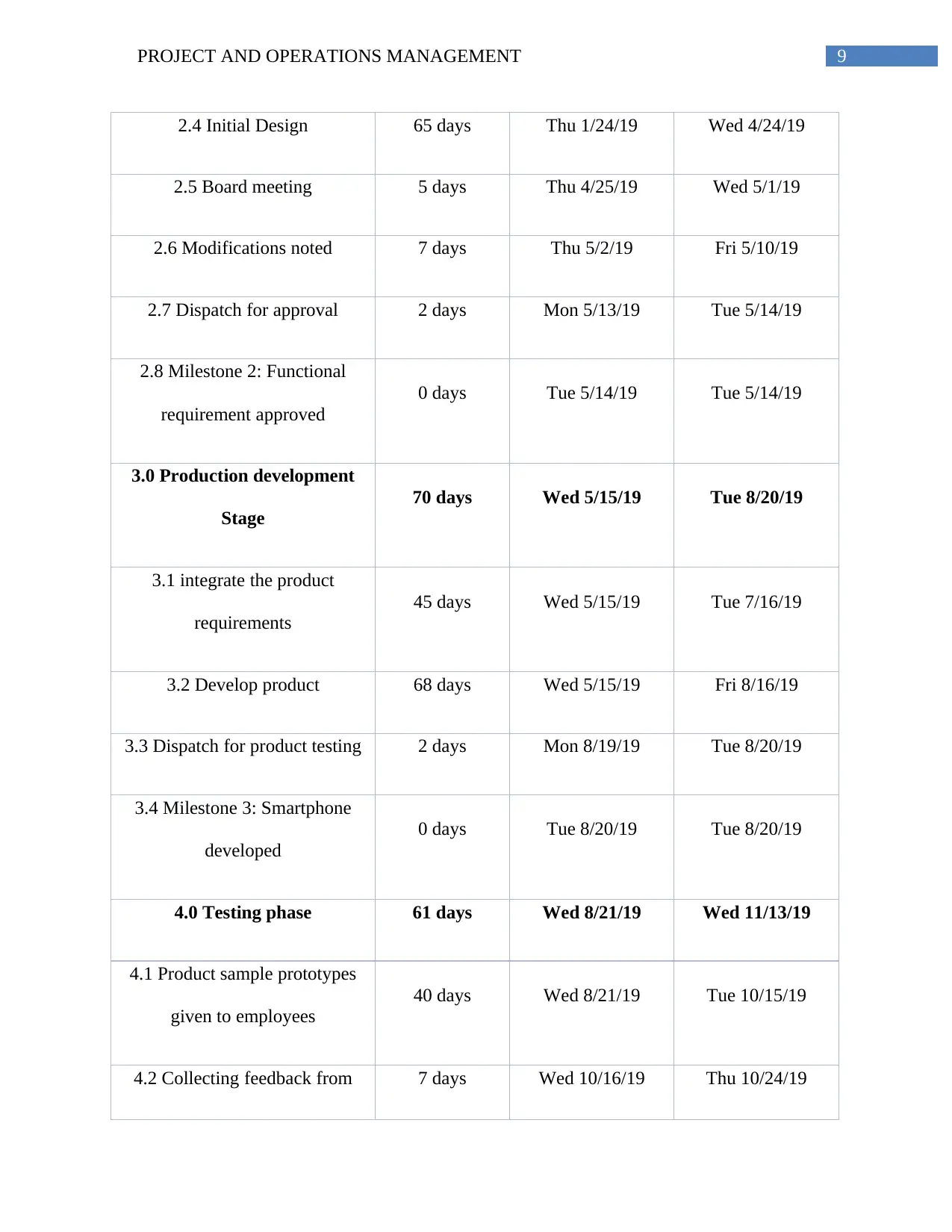
9PROJECT AND OPERATIONS MANAGEMENT
2.4 Initial Design 65 days Thu 1/24/19 Wed 4/24/19
2.5 Board meeting 5 days Thu 4/25/19 Wed 5/1/19
2.6 Modifications noted 7 days Thu 5/2/19 Fri 5/10/19
2.7 Dispatch for approval 2 days Mon 5/13/19 Tue 5/14/19
2.8 Milestone 2: Functional
requirement approved
0 days Tue 5/14/19 Tue 5/14/19
3.0 Production development
Stage
70 days Wed 5/15/19 Tue 8/20/19
3.1 integrate the product
requirements
45 days Wed 5/15/19 Tue 7/16/19
3.2 Develop product 68 days Wed 5/15/19 Fri 8/16/19
3.3 Dispatch for product testing 2 days Mon 8/19/19 Tue 8/20/19
3.4 Milestone 3: Smartphone
developed
0 days Tue 8/20/19 Tue 8/20/19
4.0 Testing phase 61 days Wed 8/21/19 Wed 11/13/19
4.1 Product sample prototypes
given to employees
40 days Wed 8/21/19 Tue 10/15/19
4.2 Collecting feedback from 7 days Wed 10/16/19 Thu 10/24/19
2.4 Initial Design 65 days Thu 1/24/19 Wed 4/24/19
2.5 Board meeting 5 days Thu 4/25/19 Wed 5/1/19
2.6 Modifications noted 7 days Thu 5/2/19 Fri 5/10/19
2.7 Dispatch for approval 2 days Mon 5/13/19 Tue 5/14/19
2.8 Milestone 2: Functional
requirement approved
0 days Tue 5/14/19 Tue 5/14/19
3.0 Production development
Stage
70 days Wed 5/15/19 Tue 8/20/19
3.1 integrate the product
requirements
45 days Wed 5/15/19 Tue 7/16/19
3.2 Develop product 68 days Wed 5/15/19 Fri 8/16/19
3.3 Dispatch for product testing 2 days Mon 8/19/19 Tue 8/20/19
3.4 Milestone 3: Smartphone
developed
0 days Tue 8/20/19 Tue 8/20/19
4.0 Testing phase 61 days Wed 8/21/19 Wed 11/13/19
4.1 Product sample prototypes
given to employees
40 days Wed 8/21/19 Tue 10/15/19
4.2 Collecting feedback from 7 days Wed 10/16/19 Thu 10/24/19
Paraphrase This Document
Need a fresh take? Get an instant paraphrase of this document with our AI Paraphraser
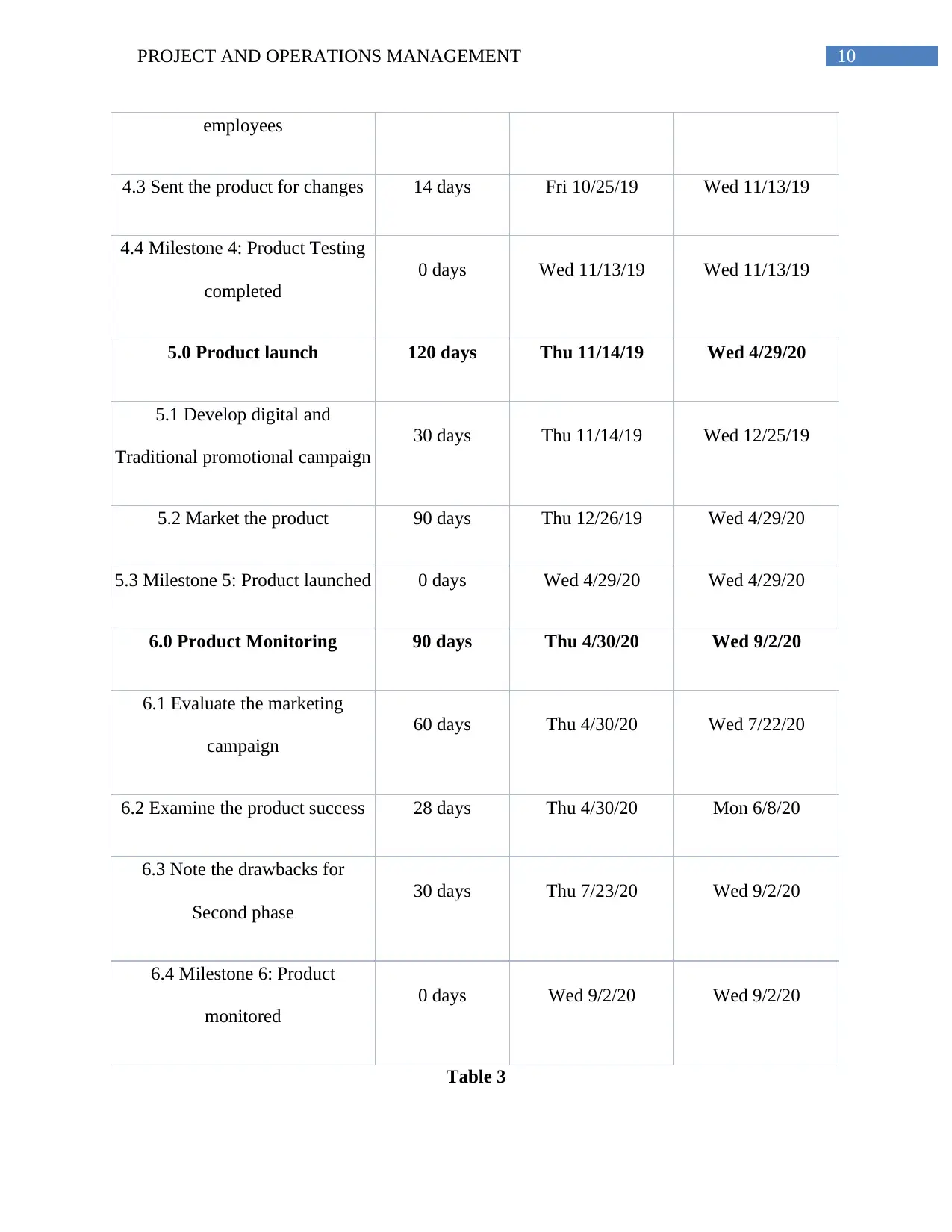
10PROJECT AND OPERATIONS MANAGEMENT
employees
4.3 Sent the product for changes 14 days Fri 10/25/19 Wed 11/13/19
4.4 Milestone 4: Product Testing
completed
0 days Wed 11/13/19 Wed 11/13/19
5.0 Product launch 120 days Thu 11/14/19 Wed 4/29/20
5.1 Develop digital and
Traditional promotional campaign
30 days Thu 11/14/19 Wed 12/25/19
5.2 Market the product 90 days Thu 12/26/19 Wed 4/29/20
5.3 Milestone 5: Product launched 0 days Wed 4/29/20 Wed 4/29/20
6.0 Product Monitoring 90 days Thu 4/30/20 Wed 9/2/20
6.1 Evaluate the marketing
campaign
60 days Thu 4/30/20 Wed 7/22/20
6.2 Examine the product success 28 days Thu 4/30/20 Mon 6/8/20
6.3 Note the drawbacks for
Second phase
30 days Thu 7/23/20 Wed 9/2/20
6.4 Milestone 6: Product
monitored
0 days Wed 9/2/20 Wed 9/2/20
Table 3
employees
4.3 Sent the product for changes 14 days Fri 10/25/19 Wed 11/13/19
4.4 Milestone 4: Product Testing
completed
0 days Wed 11/13/19 Wed 11/13/19
5.0 Product launch 120 days Thu 11/14/19 Wed 4/29/20
5.1 Develop digital and
Traditional promotional campaign
30 days Thu 11/14/19 Wed 12/25/19
5.2 Market the product 90 days Thu 12/26/19 Wed 4/29/20
5.3 Milestone 5: Product launched 0 days Wed 4/29/20 Wed 4/29/20
6.0 Product Monitoring 90 days Thu 4/30/20 Wed 9/2/20
6.1 Evaluate the marketing
campaign
60 days Thu 4/30/20 Wed 7/22/20
6.2 Examine the product success 28 days Thu 4/30/20 Mon 6/8/20
6.3 Note the drawbacks for
Second phase
30 days Thu 7/23/20 Wed 9/2/20
6.4 Milestone 6: Product
monitored
0 days Wed 9/2/20 Wed 9/2/20
Table 3

11PROJECT AND OPERATIONS MANAGEMENT
⊘ This is a preview!⊘
Do you want full access?
Subscribe today to unlock all pages.

Trusted by 1+ million students worldwide
1 out of 28
Related Documents
Your All-in-One AI-Powered Toolkit for Academic Success.
+13062052269
info@desklib.com
Available 24*7 on WhatsApp / Email
![[object Object]](/_next/static/media/star-bottom.7253800d.svg)
Unlock your academic potential
Copyright © 2020–2025 A2Z Services. All Rights Reserved. Developed and managed by ZUCOL.





